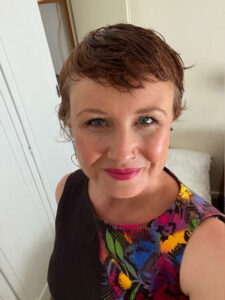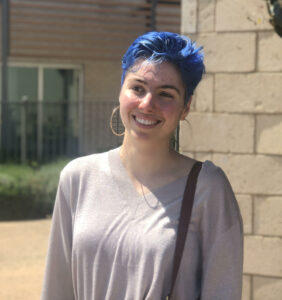By Lou and Isabelle
LOU: I have no idea how I heard about Better Together, Australia’s LGBTIQA+ Conference, but I know that the moment I heard about it, I needed to attend. I’m Lou and I’m a palliative care nurse in Australia. I believe that the work we do is important and meaningful, heart-centered and holistic. I also believe that many of the processes and methods of engagement that we employ lack nuance due to the conservative, heteronormative model within which we practice. I’m also a 42-year-old cis woman—ticking the heteronormative boxes of husband and two children—who discovered less than two years ago that I was not, in fact, straight.
Relatively speaking, I’m still a “Baby Bi+.” After coming out to my husband and a small group of online friends at the time of my “Bisexual Awakening,” I experienced an initial surge of joy and belonging. I didn’t have a queer community on the ground though. As far as I knew, all of my friends were straight, and as I adored my husband and our marriage, I didn’t feel that my newly discovered sexual identity had any practical relevance in my life. I wrote at the time, “On one hand, it’s been a mere two and a half weeks. On the other hand, it’s been over two decades. Depending on how I look at it, my bisexual awakening has had very little impact on my life. Depending on how I look at it, it has been a life-changing discovery.”
As the months ticked by, so too did my labels change. In a constant state of flux and self-exploration, I’ve gathered nuance and micro-labels along the way, and these days if pressed, I identify somewhere in the demi/panromantic realm. Mostly I just tell people I’m queer.
At the same time, I’ve also started to doubt myself. In quiet moments when the voice in my head steals the mic, I’ve wondered if I just made it all up. I wonder if I decided I was bi because all the cool kids were; if I was experiencing FOMO as the only straight in the (online) village and so grabbed the closest label off the shelf and ran with it. The voice shouts “being queer online doesn’t count, it’s what you do in real life that matters.” It tells me I’m not Queer Enough. Not Out Enough. It tells me that demi/panromantic is basically just the same as wanting to sit on the couch and cuddle your best friends and if that isn’t straight girl behavior then what is?
I volunteered at Better Together to connect with my community, to expand my knowledge of the health needs and experiences of the LGBTIQA+ humans with whom I work, and to grow my understanding of the complex, gut-wrenching, and heart-soaring ways in which we intersect as dynamic, complicated, messy, beautiful humans. If I’m honest with myself, I also volunteered because I didn’t think I was queer enough to justify the cost of the ticket, and volunteering gave me a robust philanthropic justification for being there. Regardless of the why, I made it, and I was not disappointed.
Better Together is presented by The Equality Project – an Australian LGBTIQA+ charity that brings LGBTIQA+ people and allies together to promote a better, more just, and fairer society for all Australians. This year’s conference saw 848 people meeting by Karrawirra Parri (River Torrens) on Kaurna Country (Adelaide) for two days, to hear 139 speakers over 93 sessions. Three hundred and twenty-one participants attended on a full or partial scholarship. It was a celebration of hope, a sharing of grief, a melting pot of ideas and a strengthening of connections. It was bold and loud; it was intimate and soulful. Better Together embraced and elevated all letters of the rainbow acronym and felt wonderfully bi+ inclusive with several sessions and speakers representing the bi+ spectrum. I have never felt so affirmed in my life.
Hands down my favorite session of the weekend was the one that I almost missed. One of the brilliant disappointments of conferences like Better Together is that you simply cannot attend every session, and sometimes you have to flip a coin to choose which path you follow. The session I chose was shorter than I thought, and so it was on a whim that I wandered 30 minutes late into Robyn Ochs’ session “Beyond the Binary.”
ISABELLE: It’s in this space where I appear, not knowing Lou at all, or anyone else in the room, for that matter. But I was about to share with her, and the rest of the room, truths I’d never even known how to articulate. Let’s backtrack a little. I’m Isabelle, a queer non-binary climate scientist, activist, and lover of puns and op shops (second-hand stores run by charities). Depending on the day you catch me, I’m either shit-scared, worried, or hopeful about humanity’s response to the climate crisis. I know that the struggle for climate justice is inextricably tied with the rights of First Nations people, women’s rights, and queer rights. I try to feel like I’m doing enough in the face of all these crises.
Like Lou, I’ve had my own journey with labels and doubts. I wonder at how queer I’d be if I was born in another era, without the visibility our community has carved out for ourselves. I wonder if I’m actually pan/ace/non-binary or if I’m just a chronic overthinker. I recognize my privilege as a white, well-educated, female-passing person. I feel incredibly grateful for an affirming, welcoming, community that has constantly soothed these doubts and inspired me to both love and fight harder.
And it was in this context that I landed, with Lou and perhaps a hundred others, in Robyn’s session. We started with a simple premise: labels are, sometimes, useful tools. However, labels are inherently binary—you either “are” or “aren’t” any given label. As a result, labels are, inherently, limited. And it was these limitations that we explored.
Imagine a spectrum, where “one” represents exclusive attraction to genders different from your own and “seven” represents attraction to genders similar to your own. If someone described themselves as gay, what number would you imagine them to be? Seven, perhaps? We tested this—dozens of people making a physical number line, and found self-described gays at every single number. The same thing happened when we explored gender identity and sexual/romantic attraction. There were no rules. It makes you look at people’s labels differently, doesn’t it? Just as we choose carefully how we describe our lives outside of the queer community, we also choose our labels carefully within the community—simplifying the complex, messy, truth that is our identities.
It’s this thought that has followed me since the workshop; this idea that our identities are too diverse, too fluid, too real to be neatly tied down by one—or even two or three—binary labels. I don’t think I’m alone in this perspective shift; I could almost hear everyone having their “What even are labels?!” moment as the session progressed, epitomized by one attendee revealing they were no longer convinced of their own heterosexuality. In the end, labels have utility for sharing and communicating. But whatever words you use, you are valid and welcome and real.

Lou loves her family, creative writing and palliative care nursing. She collects notebooks, lip balms, and later-in-life labels, and specializes in overthinking, courting burnout, and thriving under pressure.

Isabelle is a queer non-binary climate scientist, activist, and avid collector of random facts based on Bidigal Country (Sydney, Australia).

